| Conservation of the Mount Zion Section |

|
During November 2007-June 2008 conservation measures were carried out on Zion Gate. The conservation work, undertaken on behalf of the Israel Antiquities Authority and underwritten by the Prime Minister's Office, was implemented by the Jerusalem Development Authority. Eran Hemo directed the project, with assistance from Yoram Sa'ad (professional guidance), Avi Mashiah, Amir Freundlich and Yuval Avraham (planning), Ofer Cohen and Yael Rosenthal (engineering), Jacques Neguer and Mark Avrahami (artistic conservation) and Fuad Abu-Taa'(head conservator). The work was carried out in the field with the help of the following laborers: Ahmed Abu-Tir, Mohamed Abu-Snina, Nazar Natsha, Ashraf Juda, Masuad Juda, Rashid Jatt, Jihad Zagal, Walid Hiat, Faras Hamad, Hamdan Mohamed, Rashid Mohamed Ali, Nafaz Saror and Tarik 'Isa.
During February-March 2008 the Mt. Zion section of the city wall underwent conservation treatment which was implemented by Avi Perets (head conservator) and the following laborers: Khalid Abu-Snina, Mohamed Abu-Ramilla, Wahal Basti, Ahmed Da'is, Mufid Samara and Badar Shaludi.
|
The Mount Zion section is part of the southern wall of the Old City. In the past this section of the wall was strategically very important as a position that controls the region to its south. Zion Gate, which is set in the wall, is one of the main pedestrian entrances to the Old City and the Jewish Quarter thanks to the large car park that was built next to it.
Zion Gate is fraught with national symbolism, hence the sensitivity that is required in treating it.
Physical Data
This section of the wall is c. 400 m long and consists of seven segments (89-95). Its outside and inside façades extend over an area of c. 5,200 sq. m and c. 4,000 sq. m respectively. The height of the wall varies the length of it, in accordance with the topography and the soil debris that accumulated alongside it. The wall is 16 m high at its western end; the center tower is 9 m high and it is c. 15 m high in the eastern corner. The inside face of the wall is 8 m high in the western corner and 14 m high in the east. The elevation of the wall at Zion Gate is approximately 645 m above sea level.
Conservation Values:
More than anything Zion Gate symbolizes the struggle for the Old City. The treatment of the gate was carefully done taking into account its national significance. Besides the gate's historic values, other values also find expression during the conservation planning of the monument:
Historical Values.
The gate was built by Suleiman the Magnificent. For the past 470 years or so it has been part of Jerusalem's city wall. Its construction was the topic of considerable disagreement from the day it was erected because Mount Zion was left outside the city limits. The gatehouse is associated with the Jewish Quarter and is even referred to as the 'Gate of the Jews'.
The most significant historic event since the construction of the gate is the attempt that was made to breach it in May 1948. Then, as in the Six Day War of 1967, it was part of the border and where much of the fighting took place. The gate bears the physical evidence of the effort to break through to the Jewish Quarter and has therefore come to symbolize the capitulation of the quarter (1948) and the unification of Jerusalem (1967). Its national-historic value is derived from this. Today the gate serves as an entry point to the Old City for groups of students and tourists and discussions are held there about national heritage and the battle heritage of Jerusalem.
Urban Values. As the gate in the southern wall that leads to Mount Zion the structure's urban importance is primarily local. The gate links the Old City with the buildings that are on Mount Zion including David's Tomb, which is sacred to Jews, Christians and Muslims; the Hall of the Last Supper; the Armenian Church; the cemeteries and the Church of the Dormition.
From a transportation standpoint the gate serves as a point of egress for vehicles coming from the Old City. On Saturdays and holidays it also constitutes the only exit for vehicles from the city. Its proximity to the car park that was built outside Zion Gate has turned the gate into an important assembly point for groups of visitors.
Due to its location, the gate cannot be seen from the city streets. The walls of the cemeteries adjacent to the gate and the structures that are built on Mount Zion block it. The gate gradually comes into view as the pedestrians approach it.
Architectural Values. . The gate's facade is adorned with impressive decorations. Decorated stones are scattered across area of the facade, around the opening of the gate, around the arrow loops and in the upper sentry post.
The standard of the architectural design and the decorations of the gate do not fall short of those of Jaffa Gate and Lions' Gate. The flat arch of the opening is similar to the structure of the arch in Damascus Gate. Inside the gate is a guardroom and an ascent to the roof of the structure. Zion Gate has been preserved in its entirety as an "angled" gate, even though it functions as a passage for modern transportation.
Physical Problems:
Zion Gate was damaged during the attempt to breach it in 1948 and the stones in the gate suffered considerable destruction. On many of the stones it is apparent that the damage to them has accelerated the deterioration processes. Many parts of the stones were loose and they presented a hazard to pedestrians that passed through the gate.
Caper bushes took root in the joints between the damaged stones and a microbiological layer covered parts of the damaged stone; this obscured the gate's decorations and even hastened the destructive process (Fig. 1, 2).
Vehicles passing through the gate caused mechanical damage to the gate's pillars and walls (Fig. 3, 4). A layer of calcite encrustations and soot covered most of the stones inside the gate. This is mostly caused by the pollution of vehicles that pass through it. This layer has "encased" the stone beneath it, a fact that hinders the removal of it and weakens the stone.
For the guards that stood on the wall there is an elevated walkway was built along the inside of the wall, on either side of the gate, (Fig. 5). The horizontal surface of this walkway is not sealed and therefore rainwater has penetrated through it into the core of the wall. The seepage of rainwater has resulted in vegetation taking root and an acceleration of the destruction cycle.
Conservation Principles
The discussion concerning the conservation of the Zion Gate is different than the discussion about the rest of the parts of the wall. For the most part it is possible to map the string of historic events that shaped the different sections of the city's wall and logically select the type of treatment based on the values embodied in them; however, in the case of Zion Gate we were confronted with a planning dilemma. As previously mentioned, two events have shaped the appearance of the gate: its construction by Suleiman and the attempt to breach it in 1948, which damaged its facade and turned it into a symbol for the Jewish people. When asked to conserve the gate we could not ignore the tension between the architectural value and the national-historic value. That being the case, we were asked to decide whether to emphasize the architectural value and rehabilitate the considerable battle damage in the gate structure or conversely stress the national-historic value and preserve the battle damage.
The Conservation Concept vis-a-vis the Gate Structure
Zion Gate's Facade. When we first embarked on conserving the gate it was clear to us that the attempt to breach the structure in 1948 left its mark on the gate's facade more than any other event since its construction. Therefore, we thought it proper to make every effort to preserve the scars of the event. Nonetheless, as a gate whose architectural and design quality are preserved in its plan, we also wanted to stress the original aesthetic value of the gate structure. To this end we sought to achieve the delicate balance between restoring architectural elements and preserving the damage in the stone. In all of the proposed planning alternatives, preserving the signs of the breach from 1948 was of the utmost importance and the architectural values were emphasized differently.
The alternative that was selected is the one that preserves the national-historic values in the gate's facade, namely, the bullet marks, which are a kind of diagram of the battle on the facade, by stabilizing the stones that are severely deteriorating as a result of the damage from the fighting. The intervention preserved the architectural values. It was focused in the region of the poorly preserved arch and commemorative inscription that cites the gate's builder - Sultan Suleiman - and its date of construction - 1540 (Fig. 6).
Many historical photographs of the gate were collected and they facilitated an in-depth examination of alternatives for the conservation of the inscription and the decorations.
The Inside Facades of the Gate Structure. Unlike the front of the gate, no signs of fighting are noticeable on the facades that face the Old City. The main idea that guided us here was restoring the architectural value to the structure and its stabilization.
Conservation Measures inside the Gate Structure
Facades.The facades of the gate structure's interior were steam cleaned and the conservation measures included completing the stonework using a lime-based mortar. Stainless steel pins were implanted in loose pieces of stone in order to reinforce them. This was done without covering up the signs of damage on them.
The artistic conservation work highlighted the decorations and the commemorative inscription (Figs. 7, 8). This way we re-exposed the design quality of the gate which was obscured beneath layers of soot and vegetation. The arrow loops and drainage openings on the roof of the gate structure were treated - the joints were grouted, the drainage was improved by increasing the pitch of the slopes and sealing the pavement.
Stone Conservation. The stones in the gate were mapped and ranked according to three levels of deterioration: stones that are in immediate danger, stones that are severely deteriorated and stones that are slightly weathered. The extent of the conservation intervention required for each stone was determined accordingly.
For the sake of stabilizing the stone we first treated the microbiology that had developed in the damaged places and which had accelerated the deterioration of the stone. Afterward the stone was stabilized in the areas that had been damaged during the hostilities and the joints were grouted with mortar. The conservation work on the stone included replacing missing stonework with stone and lime-based mortar and reinforcing the stone by means of stainless steel pins (Fig. 9).
Bearing in mind the value of the original material and its contribution to the authenticity of the monument, only those stones that had lost their load bearing capacity due to the deterioration processes and destruction were replaced. The replacement of stone and completion of stonework were done utilizing stone that is indigenous to Jerusalem and its environs, of the kind that was commonly used in the stone "mosaic" in the wall.
The Gate Arch and Inscription. During the intervention the existing condition was cleaned and documented; later additions were removed; the field of the arch structure was documented and analyzed; a uniform hue was restored to each stone and a homogenous appearance was created for the inscription; the remains of the letters in the inscription were highlighted to facilitate the reading of it, without covering over the traces of damage from the gunfire and mortars on the surface of the gate (Figs. 10, 11, 12).
Decorations. The decorations in the gate's interior underwent careful artistic conservation in order to restore them to their original state; the layers of calcite encrustations were removed by repeatedly applying chemical compresses to them and on some of the decorations a layer of ancient paint was exposed that adorned them. The ceiling inside the gate structure, which was plastered, was covered with a light colored protective paint that is resistant to soot (Fig. 13).
Commemorative Plaque. A stone commemorative plaque memorializing the attempt to break into the Old City in 1948 was erected inside the gate by representatives of the Harel Brigade Association when the city was reunified in 1967. The plaque was anchored to the wall in a manner that damaged the stone and blocked an arrow loop that had also been sealed with cement (Fig. 14). In order to improve the quality of the gate's interior we sought an alternative location where the plaque could be positioned in a way that would not harm the gate's stones. After negotiating with representatives of the Harel Association a compromise was reached whereby it was decided to place the plaque inside the gate, next to the wall of the monument but away from the stone. Thus in addition to displaying the commemorative plaque we exposed the Ottoman arrow loop and restored the natural lighting and ventilation through it, into the gate's interior (Figs. 15, 16).
Preventive Treatment. In order to protect the monument from being struck by motor vehicles, we built a new course of stone next to the façade along the level of the passage. This course serves as a sacrificial layer.
Conservation Measures Conducted on the Mount Zion Wall. The conservation work that was done in this section included: removing vegetation that had taken root in the core of the wall; stone conservation; completing the stonework; grouting the joints with lime-based mortar; filling in cracks at the top of the wall and sealing it with lime-based mortar that was applied in a smooth convex fashion.
Conclusion
With the conclusion of the work at Zion Gate the architectural values of the structure were emphasized without covering over the battle damage to its facade. Today, the interior of the gate is illuminated and airy thanks to opening the arrow loop. The ceiling of the gate's interior was treated with paint that is soot resistant. The conservation work that we implemented does not ensure that the condition of the gate will not deteriorate again over time to its previously state. Limiting the number of vehicles that pass through the gate will aid in maintaining the quality of the gate's restored interior. This measure, which we consider feasible during the daytime hours, will help protect the gate and will make it easier for the pedestrian traffic passing through the gate. Apart from this, further use can be made of the gate structure by preparing the historic passage through it to the city wall promenade.
On July 28, 2008 an opening ceremony for the restored gate took place in which the mayor of Jerusalem, Mr. Uri Lupolianski, the director of the Israel Antiquities Authority, Mr. Shuka Dorfman, and veterans of the Palmach participated.
|
|
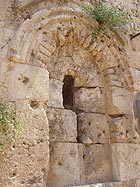
|
| 1. Stone deterioration and vegetation that took root in the arrow loop. |

|
| 2. The gate's facade, damage in the stonework. |
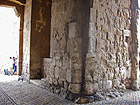
|
| 3. Damage caused by vehicles and soot marks inside the gate prior to the conservation measures. |

|
| 4. Damage caused by vehicles and soot marks inside the gate prior to the conservation measures. |

|
| 5. Vegetation growing along an unsealed horizontal surface. |
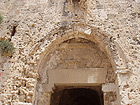
|
| 6. The gate arch and dedicatory inscription in Zion Gate, prior to the commencement of work. |
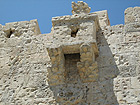
|
| 7. The sentry post above the Zion Gate after the completion of the conservation work. |
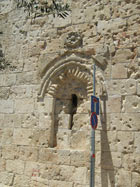
|
| 8. An arrow loop in the gate's facade after the conservation work.. |
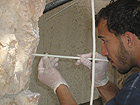
|
| 9. Reinforcing damaged stones with the aid of stainless steel pins. |
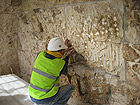
|
| 10. Applying a protective layer of soot resistant paint to the vault inside the gate structure. |
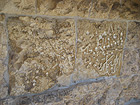
|
| 11. The commemorative plaque that was installed on an arrow loop, prior to relocation. |
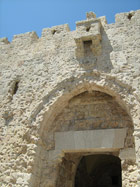
|
| 12. The commemorative plaque after it was relocated away from the city wall, and the exposure of the arrow loop. |
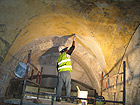
|
| 13. View of the gate's interior after the work was completed. |
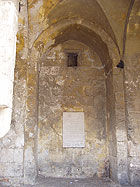
|
| 14. Completing the stonework in the dedicatory inscription. |
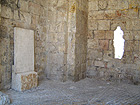
|
| 15. The dedicatory inscription after the conservation work. |
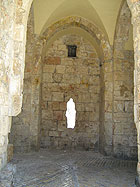
|
| 16. The gate arch and the dedicatory inscription in Zion Gate upon the completion of the work. |
|















